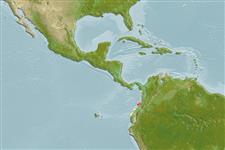Elasmobranquios (tiburones y rayas) (sharks and rays) >
Torpediniformes (Electric rays) >
Narcinidae (Numbfishes)
Etymology: Narcine: Greek, narke = numbness (Ref. 45335).
Environment: milieu / climate zone / depth range / distribution range
Ecología
marino demersal; rango de profundidad 10 - 35 m (Ref. 116153). Tropical
Southeast Pacific: Colombia and Ecuador.
Tamaño / Peso / Age
Maturity: Lm ? range ? - ? cm
Max length : 16.5 cm TL macho / no sexado; (Ref. 116153); 33.0 cm TL (female); peso máximo publicado: 54.90 g (Ref. 116153); peso máximo publicado: 54.90 g
Collected from shallow and sandy bottom area. The 33 cm TL pregnant female has a total of 12 embryos with 2 females and 10 males, measuring between 6.2 and 6.8 cm TL (Ref. 116153). Males mature at ca. 18 cm TL (Ref. 114953).
Life cycle and mating behavior
Madurez | Reproducción | Puesta | Huevos | Fecundidad | Larva
Eschmeyer, W.N. (ed.), 2003. Catalog of fishes. Updated database version of March 2003. Catalog databases as made available to FishBase in March 2003. (Ref. 46206)
IUCN Red List Status (Ref. 130435: Version 2024-1)
Threat to humans
Harmless
Human uses
Herramientas
Special reports
Download XML
Fuentes de Internet
Estimates based on models
Preferred temperature (Ref.
123201): 26.8 - 27.3, mean 27.1 °C (based on 12 cells).
Phylogenetic diversity index (Ref.
82804): PD
50 = 0.5000 [Uniqueness, from 0.5 = low to 2.0 = high].
Bayesian length-weight: a=0.01175 (0.00470 - 0.02937), b=2.88 (2.66 - 3.10), in cm total length, based on LWR estimates for this (Sub)family-body shape (Ref.
93245).
Nivel trófico (Ref.
69278): 3.1 ±0.3 se; based on size and trophs of closest relatives
Resiliencia (Ref.
120179): Bajo, población duplicada en un tiempo mínimo de 4.5-14 años (Assuming fecundity<100).
Fishing Vulnerability (Ref.
59153): Low vulnerability (23 of 100).
